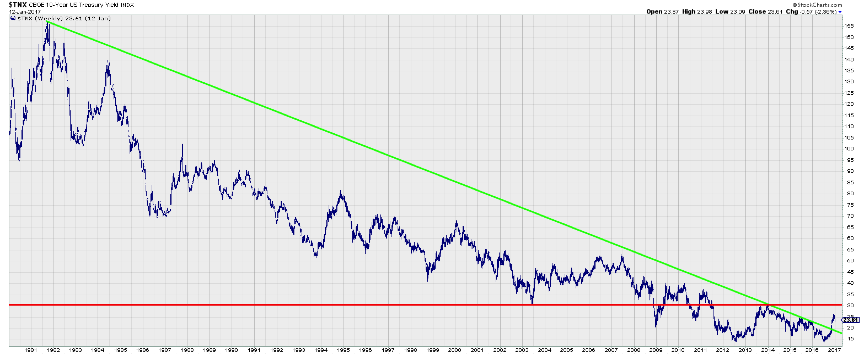By now, you have likely heard something, either directly or indirectly, about “The Great Rotation” from bonds into stocks.
Just googling the term will pull up a whole host of articles written by practically every major financial news organization in existence, and it seems that every “bond king” and market strategist has weighed in with his or her own respective opinions on the matter.
In short, the line of thinking behind the rotation is that, after 30-plus years of interest rates in the United States generally falling and bond prices, resultantly, rising, an inflection point has been reached or is approaching where now interest rates will rise over time and bond prices will suffer.
Most people, at least, seem to agree on that point to some extent, though what exactly that will mean for bonds and stocks as investments remains widely contested.
Some have argued that this dynamic will prompt massive money flows to move from bonds into the stock market (producing the titular “great rotation”), while others contend it will not have as big of an effect on aggregate portfolio allocations as expected.
The financial media has tried quite hard to pitch this as a battle between Bill Gross, the well-known portfolio manager at Janus, and Jeff Gundlach, founder of DoubleLine Capital, who have shared a contentious past and don’t mind taking jabs at each other.
However, to me, they seem to be saying the same thing except for a slight difference of opinion on the “key level” in the bond market. Gross has come out and said that 2.6 percent on the 10-Year U.S. Treasury is the line in the sand for the end of the bond bull market, while Gundlach argues that “second-tier managers” can focus on 2.6 percent, but 3 percent is the level to watch to “define the end of the bone bull market from a classic chart perspective.”
In other words, both of these very smart bond guys, despite their minor differences, believe we are getting close to hitting that inflection point, with Gundlach going on to say that it is “almost for sure” that the 10-year is going to take out 3 percent this year.
Meanwhile, we have already said that it is very likely that last July marked the bottom for rates, when the 10-Year U.S. Treasury made an undercut low below the 2012 nadir before quickly recovering to shoot up about 125 basis points (almost a 100 percent move in percentage terms) by the end of 2016.
The future trajectory for rates, therefore, does appear to be upward, but the exact path remains an unknown.
Just as yields didn’t go straight down over the last three decades, they will not go straight up in the years ahead, as the last few weeks have reminded us with the 10-Year falling about 10 percent.
Also, while the long-term chart of the 10 Year going back to the early 1980s looks to have already broken its downtrend line when using a linear scale (see chart above), 2.6 percent, 3 percent and 3.5 percent may all act as fairly strong resistance, too. It would not surprise me to see interest rates remain range-bound for much of 2017 until expectations about economic growth and inflation pick up enough to power rates above this resistance block.
Three percent, especially, may be tough to overcome in the next few months until we see just what the new administration’s policies are going to be.
So, what does this all mean for the stock market? Well, market strategists are sort of torn on that point, as well.
Jeffrey Kleintop, chief global strategist at Charles Schwab, believes the fund flow shift from bonds to stocks that has taken place over the last two months, which has added $3 trillion to global equity values while bond values have dropped by $2 trillion per Bloomberg, “marks an important juncture” and has “years left to run.”
Conversely, David Kostin of Goldman Sachs argued recently that, many institutional investors, the ones who really move markets, are restricted from moving money out of bonds and/or owning stocks, so the impact of the “great rotation” may already be approaching its upper limit since allocations to debt securities are already near the lowest levels of the last 30 years.
The truth may lie somewhere in the middle, then.
Overall, interest rates are still likely to be low and accommodative for the next couple of years when compared to their long-term averages, which should help keep interest in stocks high.
At the same time, if we are correct and earnings growth picks up in the quarters ahead, that should bode well for stock prices, so we may still see a large amount of money flowing back from bonds into stocks, particularly among retail investors chasing returns, if stock prices go up while bonds are losing value and still yielding relatively low rates.
However, David Kostin does make a fair point that we are certainly not going to see most fixed income investors suddenly switch to stocks – institutional investors are generally limited in what they can invest in by the terms of their portfolio agreements, and bonds will still play a large role for retail investors who need the diversification and income benefits that they can provide.
So, on a net basis, I’d say that “the great rotation” may help provide a tailwind for stocks, but it might not be as “great” as many believe. At the end of the day, earnings and economic growth are still the primary drivers behind the stock market and, without this growth, interest rates and stocks may both have trouble rising significantly from current levels.
This column was prepared by Raymond James and brought to you by Charles Tumlin, managing director at TLS Wealth Management of Raymond James. Tumlin is a financial advisor with Raymond James & Associates, Inc., member New York Stock Exchange/SIPC located at 2015 Boundary St., Suite 220, Beaufort SC 29902. He can be contacted at 843-379-6100 or charles.tumlin@raymondjames.com or by visiting www.tlswealthmanagement.com.




